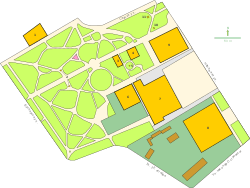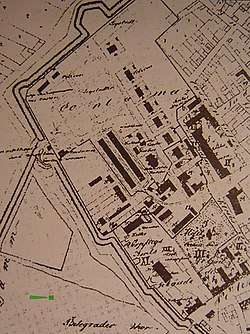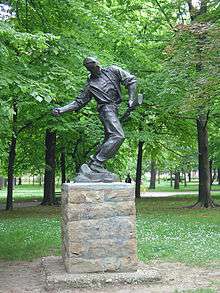City Park in Zemun
| City Park in Zemun | |
|---|---|
| Градски парк у Земуну | |
|
Main promenade in winter | |
 Location within Belgrade | |
| Location | Zemun, Belgrade |
| Coordinates | 44°50′27″N 20°24′32″E / 44.840842°N 20.408962°ECoordinates: 44°50′27″N 20°24′32″E / 44.840842°N 20.408962°E |
| Open | Open all year |
City Park in Zemun or Zemun Park (Serbian: Градски парк у Земуну / Земунски парк) is a park in Zemun, a neighborhood of Belgrade, the capital of Serbia. Located on the rim of the Old Core of Zemun, it is considered today as one of the symbols of Zemun and one of the most beautiful parks in Belgrade.[1]
Location

The park is located in the Zemun's neighborhood of Donji Grad. It has an irregular shape and is bounded by the streets Nemanjina on the west, Nikolaja Ostrovskog and 22. Oktobra on the south, Vrtlatska while on the north the border is marked by the Savska street and the complex of the Clinical Hospital "Zemun". With the smaller, surrounding green and wooded areas between the buildings and along the streets, it forms a green belt, stretching from Zemunski Kej on the east, across Tošin Bunar on the west.[2][3][4]
History

On the location of modern park, from 1730 to 1871 there was Kontumac, or the quarantine hospital. As Zemun was Austro-Hungarian border town to Serbia, which was administered by the Ottoman Empire to 1815 (de facto; de jure to 1878), the quarantine was built for both the passengers and the goods coming from across the Sava river.[4][5] List of notables held at Kontumac at various times includes rebellion leader Karađorđe, writer Joakim Vujić, French poet Alphonse de Lamartine and Danish author Hans Christian Andersen.[6] Zemun was granted a free royal city status in 1871 and the Kontumac was closed. In 1875 the lot became a municipal property and the decision to turn it into the promenade and the park was made.[4][5]
The park was an idea of Ivan Perković, who also conducted the works on adapting the terrain into the park. The construction began in 1880 when the green area around the Great Realschule (modern Zemun Gymnasium) was formed. Original park was formed in the next 6 years and was officially open in 1886.[5][6] For a while, it was named Elizabet-Park, after the Elisabeth, Empress consort of Austria, while it got its present name after the World War I. However, the forming of the park into its present size and layout lasted for decades and was finally completed in 1931. The seedlings were supplied by the well known Viscount's Nursery Garden from the town of Ilok.[4]
The park was scheduled for reconstruction in 2008 [7] but it was postponed. A thorough reconstruction began in October 2017.[4] The reconstructed area occupies 2.38 ha (5.9 acres) and covered the reconstruction of all pathways, fences and stairways replacement of the benches, decorative lights on additional monuments and construction of another children's playground which will be separated from the rest of the park with the newly formed wall of hedge.[8] The reconstruction was finished on 4 May 2018.[6]
Characteristics
The park covers an area of 7.72 ha (19.1 acres). It is populated by the both deciduous and conifer trees. 15 individual trees are protected by the law.[5] In total, there are 1,300 individual trees in the park.[6]
In 1932, the building of the Faculty of Agronomy was constructed in the southern section of the park. A meteorological equipment was also located in the park until October 1944.[4]
There are numerous sculptures and monuments in the park. Among them, in 1933 a monument to Lamartine was erected on the locatin between the two churches in the park. It commemorated Lamartine's stay in the Kontumac in 1833, during his travels to the East which he published in 1835 as the "Voyage en Orient". In 1946, two Partisan monuments were erected, commemorating the fightings with the German occupational forces during the World War II: the "Bombard" (by Vanja Radauš) and the "Hostage" (by Boris Kalin). In front of the Orthodox church, there is a monument named "Hačkar", a gift from the people of Armenia to the people of Yugoslavia after the help from the Yugoslav pilots during the aftermath of the disastrous 1988 Armenian earthquake, which struck on 7 December 1988. In 2004, a bust of poet Branko Radičević was dedicated. Remains of the Roman sarcophagus are exhibited between the gymnasium and the military barrack.[6]
There are three drinking fountains in the park and several protected individual trees of European yew and four groups of Caucasian walnuts.[8] There is also one preserved Artesian well.[6]
Buildings
Apart from Clinical Hospital "Zemun" and the Faculty of Agronomy, there are other important Zemun's buildings surrounding the park or within its borders: "Svetozar Miletić" and "Majka Jugovića" elementary schools, "Kosta Manojlović" music school, Zemun Gymnasium, Pinki Hall, Franciscan monastery of Saint John the Baptist and monastery of Sisters of Mercy. Within the park, there rare two churches, an Orthodox monastery of the Saint Archangels Michael and Gabriel and Roman Catholic chapel of the Saint Roch.[2][3][4][9] Both churches were built in the temperate Baroque style for the people who were spending time in the Kontumac and were protected as the cultural monuments in 1966.[6]
Church of the Saint Archangels Michael and Gabriel
The church was built in 1786,[4] on the location of an older, small church. It was built by Teodor Toša Apostolović (1745–1810), with his personal funds.[10] Apostolović was a Serbian merchant and philanthropist who donated the land between Bežanija and Zemun to the Serbian church municipality of Zemun, of which he was a president when the church was built. The area and the subsequent neighborhood and the main street in it ar today called Tošin Bunar ("Toša's Well") after him. After the Kontumac was disbanded, the church lost its importance.
After a large number of Russian White émigrés settled in Yugoslavia in the 1920s, especially in Belgrade and Zemun, the church was revitalized and until 1945 served as a Russian church. Within the new Communist regime after 1945, the church was largely neglected and unkempt. By 1981, the hieromonk Filaret Mićović took over the management and restored the church. However, in the process the original frescoes were completely destroyed while the church even served as a weaponry storage. Mićović obtained the permit to demolish the church completely and build a new temple covering 3,000 m2 (32,000 sq ft) instead. When Patriarch Pavle was elected as the new head of the Serbian Orthodox Church in 1991, he annulled the permit, preserving the old church.[10]
Church of the Saint Roch
The church was built in 1836[4] and, just like its Orthodox counterpart in the park, it was built on the foundation of an older chapel. It was designed by Joseph Felber, who also projected the Zemun's town hall, Magistrate in Zemun and another, Orthodox church of the Holy Trinity. After the Kontumac was turned into the park, and especially after the World War II, the church lost its importance. Today it is operational only occasionally.
Gallery
|
References
- ↑ "Istorijski zabavnik-Beograd u prošlosti: Mračna istorija Zemuna: Danas najlepši park u gradu nekada je imao mnogo strašniju namenu" (in Serbian). Dnevno.rs. 3 May 2017.
- 1 2 Beograd - plan i vodič. Geokarta. 1999. ISBN 86-459-0006-8.
- 1 2 Beograd - plan grada. M@gic M@p. 2006. ISBN 86-83501-53-1.
- 1 2 3 4 5 6 7 8 9 Branka Vasiljević (13 September 2017), "Predstoji obnova Pionirskog i Zemunskog parka", Politika (in Serbian), p. 16
- 1 2 3 4 H.Milanović - "Parkovi Beograda", Београд, 2006. ISBN 86-7856-018-5
- 1 2 3 4 5 6 7 Branka Vasiljević (5 May 2018). "Нови изглед Градског парка у Земуну" [New look of the City park in Zemun]. Politika (in Serbian). p. 13.
- ↑ Politika, 6 November 2007, p.24
- 1 2 J.S.T. (27 October 2017), "Ulepšavanje Gradskog parka u Zemunu" [Beautification of the City park in Zemun], Politika (in Serbian)
- ↑ Cultural monuments in Zemun
- 1 2 Revija 92 - "Proklinju Dositeja, slave Mladićа"
External links
| Wikimedia Commons has media related to Gradski park, Zemun. |





